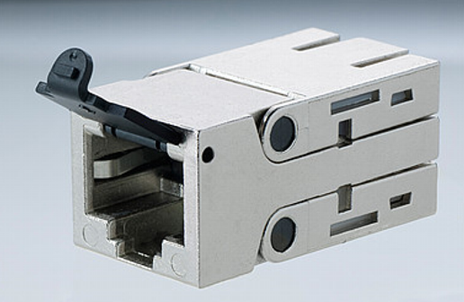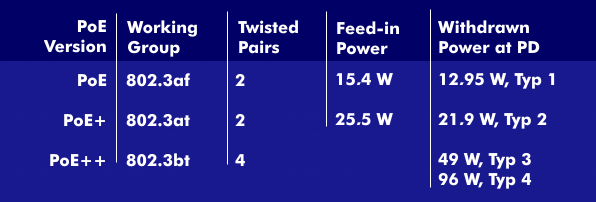power over Ethernet (WLAN) (PoE)
The 802.3afworking group deals with the standardization of the power supply of Data Terminal Equipment( DTE) via Medium Dependent Interface( MDI): DTE Power over MDI.
The standardization deals with different scenarios for existing Ethernet infrastructures to transmit power over Ethernet. Power over Ethernet( PoE) allows VoIP phones, IP cameras, wireless access points( WAP), and other devices to transmit power and data over existing LAN infrastructure.
Powering devices requires an existing data connection. Over this connection, the power sourcing equipment( PSE), which is the device that supplies the power, discovers devices that are PoE-compliant and require power. These end devices are the Powered Devices( PD). The method used for this is called resistive power discovery.
The advantage of this technology is that devices connected to the Ethernet can be supplied with power directly. This includes those located in hard-to-reach places such as IP cameras, surveillance cameras, IP telephones for Internet telephony and radio access points for WLANs. The 802.3af standard recognizes the three power classes 0, 1 and 2 with extraction powers of 4.0 W, 7.0 W and 15.4 W respectively. This allows Ethernet end devices to be supplied over a distance of 100 m. The voltage is 44 V, and the power is supplied via two pairs of wires. Higher power levels are achieved with IEEE standards802.3at and 802.3bt.
The PoE architecture can be used in Ethernet, Fast Ethernet and Gigabit Ethernet and consists of the power sourcing equipment (PSE) and the end device to be powered, the powered device (PD). There are two connection schemes for RJ45 connectors, spare pair powering via the free pins 4/5 and 7/8 of the RJ45 connector and phantom powering via the pairs of wires over which the data is also transmitted. In the most common one, the RF transformers for the input and output of the transmit and receive signals have a center tap into which the 48 V supply voltage is fed. In the other configuration, the free pin pairs 4/5 are used for the positive supply voltage and 7/8 for the negative supply voltage. The 48 V arriving in the powered devices are converted into the corresponding supply voltages in DC/DC converters.
PoE+ and PoE++, the more powerful versions
In a more powerful version PoE+ (PoEPlus), standardized by the 802.3at working group, power class 4 was introduced with a supply power of 30 W and an extraction power of 25.5 W. The IEEE working group 802.3bt has standardized a more powerful PoE method with PoE++, which is based on four wire pairs. The PSE unit extraction powers correspond to power classes 5, 6, 7 and 8 and have power values of 45 W, 60 W, 75 W and 90 W respectively. This method is also known as 4 Pair Power over Ethernet( 4PPoE). It is used in 1000Base-T and 10GBase-T, among others. PoE++ can be used to supply more powerful applications, such as lighting or large screens over 100m.
Other PoE methods
Various manufacturers have developed their own proprietary methods and offer PoE+ devices with an extraction power of 60 W and more. However, these values are not standardized by IEEE 802.3. The specifications are developed by the PoE Technology Consortium (PoETec).
In addition, there are other proprietary solutions with high power transmission. In this context, Cisco's Universal Power over Ethernet (UPoE), which is designed for 60 W and combines the two pin concepts of PoE and PoE+, and HDBaseT, also a 4-pair concept like 4PPoE with a power of 96 W, should be mentioned. Furthermore, 802.3bu deals with Power over Data Lines( PoDL) in the context of 100Base- T1 and 1000Base-T1.

-speist-die-PSE-die-einzelnen-Powered-Devices-(PD)_en.png)
_en.png)

